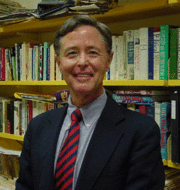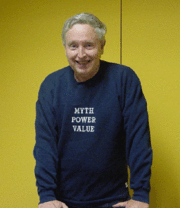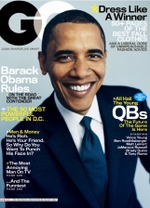Think of this as Volume 11, Number 42 of A-Clue.com, the online newsletter I’ve written since 1997. Enjoy.
There are two sides to politics, science and art.
The science of politics uses data to show trends or identify change as it is happening. Data can either be a snapshot in time or a rear-view mirror.
The art of politics is based on ideas, and what rules exist are focused on how those ideas play off one another. It’s inexact but more human. It’s focused on the present but its study is the future.
This week Earl Black, the Herbert Autrey Professor of Political Science at Rice (and brother of Emory’s Merle Black) came to Atlanta and plugged their new book, "Divided America," to the alums. It was a great chance to listen to a fine political scientist, and to see the old undergrads again.
The Blacks’ book is based on hard data and clear trend lines. The most important trend is a transformation of the political parties into firm ideological coalitions, with the drift of white Christians to the Republicans balanced neatly against the move of "non-Christian whites" and minorities to the Democrats. Thus our political system is finely balanced, and increasingly resistant to consensus, he said.
One great piece of news Dr. Black handed me personally is that my
old poli sci teacher, Gilbert Cuthbertson (left), known on campus as "Doc C,"
is still hale, hearty, and working on campus.
Doc C’s work is based on
three simple words readers of this blog know well — myth, power and
value. (See the t-shirt he’s wearing.)
Myths are the stories we tell each other about politics, values
are the lessons we draw from those stories, and power is the result.
Since MV=P, you can use this equation to find M and V, but it’s not
really math, but a work of art.
Most of my work on "political philosophy" here has dealt with
applying Doc C’s work to the concept of political cycles,
generation-long ideological trends that flow through our political
history. A crisis creates a myth which creates values. The result if a
political thesis, a set of assumptions which are then validated,
challenged, and validated again as the generation for whom the myth is
important ages.
The point I’ve been making again-and-again is that the current
Thesis, the Nixon Thesis of Conflict, is in the process of giving way
to something entirely new and different. Those to whom that Thesis were
vital are aging. The medium in which they learned this Thesis is becoming irrelevant. The tumult of our time is putting the lie to the
political ideas resulting from the Thesis, which have been taken to
extremes even as their irrelevance has become apparent.
What I have identified, through my work with the Netroots, is what
that something new is. I call it the Internet Thesis of Consensus.
While the Nixon Thesis lived best on TV, as the previous Roosevelt
Thesis of Unity lived best on film, the Internet Thesis is based on the
myths and values of the Internet. Specifically the idea that the
Internet exists because of consensus.
Your browser and the server where this story sits share a consensus,
written in software, over what the codes in this HTML file mean. This
consensus is also written into the software used to write this post,
and to point you to other locations on the Internet. The complexity of
all this is hidden. We work out from this basic consensus to accept
other files as objects. If your browser accepts a plug-in we have
consensus and you can see a movie embedded here as an object.
We accept all this at face value, but great miracles have been
required to bring it about, just as we accept TV at face value and
ignore the technology behind it. More important is that we internalize the medium’s
lessons, in this case the need for consensus, for openness, for moving
outward from where we agree rather than inward from where we disagree. Just as we earlier internalized TV’s lesson, that stories are driven by conflict and character.
The politics of Barack Obama embody this understanding. He does not
dehumanize those who disagree with him. In fact, he goes out of his way
to find agreement with them. He tells us we need to do the same in
order to meet the crises of our time — war, economic collapse, climate
change. We have to find ways to agree, rather than seeking
disagreement. That, in summary, is the Internet Thesis, distilled to
its essence.
The work of Doc B is great for explaining how a Thesis is filtered
down through the people it’s aimed at, over the course of time. So long
as a Thesis is intact, his work is great. Doc C’s work helps explain
how the ideas which govern us come to power, and how people use ideas
to create power. The generational thesis, which is a study unto itself, is also not original to me.
All I have done, over the last five years, is try to weave these
ideas into a mosaic that will help show you where we’re going, why our
course is changing, and what the new direction means. Perhaps that
makes me your Doc D. I prefer to just call myself a journalist, a self-educated tradesman whose work is made possible by the medium you are now using.
Journalists are witnesses. We are not professors. Our conclusions are tentative and ephemeral at best, almost always backed by insufficient evidence. But sometimes we are worth listening to, and the work we do is rewarding in itself.
Thanks for listening. Now go vote. Change America.













US politics is historically based on the two party system. It is assumed that when one party goes astray, then the other party gets voted in to fix things.
But this recession and financial crisis looks more like a systemic failure, connected throughout the developed world.
Maybe the two party system has led to wild oscillations that switching to the other party won’t fix.
Now, that’s a frightening thought to play with.
It may take a huge collapse and recession to force a change to a proportional representation voting system (like some in Europe). This allows for many smaller parties to be represented in government, who have to form coalitions to form a government and find policies they all agree on.
The disadvantage is that coalitions tend to frequently break down and more elections are needed.
But perhaps this time a bigger change than ‘giving the other lot a go’ is necessary.
US politics is historically based on the two party system. It is assumed that when one party goes astray, then the other party gets voted in to fix things.
But this recession and financial crisis looks more like a systemic failure, connected throughout the developed world.
Maybe the two party system has led to wild oscillations that switching to the other party won’t fix.
Now, that’s a frightening thought to play with.
It may take a huge collapse and recession to force a change to a proportional representation voting system (like some in Europe). This allows for many smaller parties to be represented in government, who have to form coalitions to form a government and find policies they all agree on.
The disadvantage is that coalitions tend to frequently break down and more elections are needed.
But perhaps this time a bigger change than ‘giving the other lot a go’ is necessary.